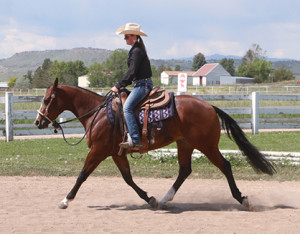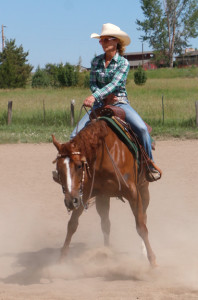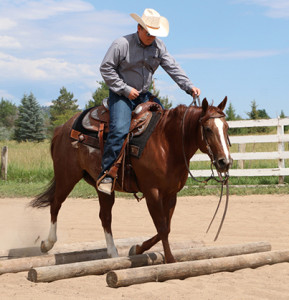Ranch Horse Riding Fundamentals – Part 2
Click here to read the complete article
Article and Photos by Kristen Spinning
 A much-touted theory suggests that practicing any skill for 10,000 hours is enough to achieve mastery. I wonder if any of those theorists have ever ridden a horse…
A much-touted theory suggests that practicing any skill for 10,000 hours is enough to achieve mastery. I wonder if any of those theorists have ever ridden a horse…
It was immediately clear, when I first dove into the whats, how-tos and wherefores of Ranch Riding, that no mere 10,000 hours, let alone a few thousand words, would adequately cover this fun and addicting class. Sure, one could describe it as a pattern class with lots of transitions. Certainly one could expand upon on its return to the fundamentals of Horsemanship. It would be easy to explain that a horse and rider simply move forward with purpose through different obstacles and maneuvers. Yet those summaries miss what’s really going on in barns, arenas, and show pens across the country.
What’s most fascinating about this discipline is how riders of all skill levels, experience, and ages are realizing benefits from Ranch Riding that help them where they need it most. In part one of this series, we explored some of the tips and techniques for honing Ranch Riding skills. Now, to discover the impact the class is having on exhibitors, it’s time to talk to some of the folks who have whole-heartedly embraced the event.
It’s hard to miss the youth and non-pro riders from Mark Guynn’s Colorado-based barn as they scoop up points and accumulate awards across the board at Ranch Riding competitions. Consistently at the top end of the judges’ cards, Guynn’s clients haven’t just found success in Ranch Riding, they’re using what they have learned to excel in other disciplines. Five of his youth riders are qualified for the AQHA Youth World, and nine of his amateurs have qualified for the World Show. These seemed like exactly the type of folks I needed to talk to to gain a deeper perspective. So, I found myself zig-zagging along county roads to the Guynn Training Center in Berthoud, Colorado. Late in June, snow still clung to the craggy peaks of the Rockies that dominated the vista.
I caught Mark and some of his crew on one of those rare summer weekends when they weren’t off showing and Mark wasn’t judging. He holds cards in AQHA, NRHA, and NRCHA. Also, both Mark and his wife, Jan, sit on the Rocky Mountain Quarter Horse Association Board of Directors and have been heavily involved in the youth program for many years. Mark also coaches the Rocky Mountain Wranglers IEA team.
The morning already hinted that heat was well on its way, so the horses were saddled and ready for a workout. Though Mark has all-around clients, he also has a large number of Reiners. The riders assembled this day all fit into the latter category. As they moved about the arena, it was strikingly obvious that it didn’t look like your average group of Reiners—they were all Ranch Riding.
Mark integrated Ranch Riding into his program about halfway through the first year that it was an AQHA class. “Initially, I used it as a warm-up for my Reiners,” he says. But the benefits began to spill out in unexpected ways. “We never used to jog,” he says. “Now, we warm up with transitions, extension, and collection. All that jogging brings their bellies up. The horses’ brains are better than when we just lope them in circles, and my non-pros aren’t locked into 10 circles to the right and 10 circles to the left.”
He finds that the horses are much more responsive with the Ranch Riding regimen. “Reiners often just lope until their horses are soft. Here, we’re doing a lot of steering. We’re all over the pen.” He prefers his students make up their own patterns, because it builds the ability to think and formulate, act decisively and smoothly, and then execute. However, it wasn’t long before his clients moved past simply using Ranch Riding for drills. They were ready to compete. It took some work to get Ranch Riding classes accepted at RMQHA shows. These days, more RMQHA kids are aiming to compete at the AQHA Youth World in Ranch Riding and Reining than in Western Pleasure or Horsemanship.
Jan sees the impact Ranch Riding has had from multiple vantage points: as a mom of youth exhibitors, as an active RMQHA board member, and as a ring-side cheerleader of the youth and amateurs in their barn. She appreciates that it offers another performance class to enter.
“You spend all that time and expense getting to the show,” she says. “It’s nice that our performance kids have something else they can do there. As a mom, you have to love it that Ranch Riding helps those kids, who are more timid, to gain confidence. The kids learn roll-backs, speed changes, and lead changes without it all coming at them so fast.” As an example, she cites the nine- and eleven-year-old boys who recently started riding with their barn and who are already on their way to the AQHA Novice Championship. She contends, “Their confidence level wouldn’t be nearly as high if they hadn’t started with Ranch Riding.”
 Jan is optimistic about Ranch Riding’s impact on horse showing in general. “It’s is a less intimidating option for open show riders to come into the breed shows.” She explains that a rider doesn’t need to have a $100,000 horse, $20,000 saddle, and custom show clothes in order to be competitive. Western Pleasure used to be an entry-level class for riders who wanted to test the waters at larger breed shows. However, the discipline has become so specialized that there is now a huge gulf between open show exhibitors and the breed shows. “If we can’t get open show people to cross over, and keep the novice riders encouraged to show, we are in trouble as a industry,” she says.
Jan is optimistic about Ranch Riding’s impact on horse showing in general. “It’s is a less intimidating option for open show riders to come into the breed shows.” She explains that a rider doesn’t need to have a $100,000 horse, $20,000 saddle, and custom show clothes in order to be competitive. Western Pleasure used to be an entry-level class for riders who wanted to test the waters at larger breed shows. However, the discipline has become so specialized that there is now a huge gulf between open show exhibitors and the breed shows. “If we can’t get open show people to cross over, and keep the novice riders encouraged to show, we are in trouble as a industry,” she says.
Ranch Riding is finding its way into all age groups. One of Mark’s clients is in her mid-70s. “Judy did Reining for a long time, years ago,” Jan explains, “But, she found she just couldn’t physically compete at that level anymore and missed it tremendously.” Even in the select or super-select divisions, one can find themselves up against riders with much greater athletic stamina. Mark suggested she try Ranch Riding. “Judy is so excited to be back in the game,” Jan continues. “It’s been so good for her socially as well. She is getting out, has new friends, and is staying active,” she says.
Don’t be fooled into thinking this class is just for Reiners. Mark sees a lot of people who have a good Horsemanship mount, and are competing in All-Around events, but the horse has a tough time going up against the dedicated Western Pleasure horses. He believes that Ranch Riding could be a good substitution to their show schedule. He suggests another good fit is a combination of Performance Halter, Ranch Riding, and Reining.
After spending the morning demonstrating their training sessions, the summer sun was beginning to melt both horses and humans. Therefore, we retired to the welcoming cool of Mark and Jan’s house in order to chat about what makes Ranch Riding important to so many people.
Shelley Diede, like many riders, was initially skeptical of Ranch Riding, but she was quickly won over. “It’s a fun event,” she says. “It hooks you pretty quick. Overall, it makes you a better rider.” A seasoned Reining and Cow Horse Boxing competitor, she added Ranch Riding to her repertoire, and she is now qualified for the World Show in all three events.
Mark and Jan’s twins, Lindsay and Luke, are huge fans of Ranch Riding, both as a training tool and as a class. They share the sentiments of so many youth riders that it helps their riding, boosts their confidence, and is just plain fun to do.
Kate Peine initially rode with Mark as a youth and came back to showing after college and settling into a solid career. “When I went to college, I knew I wanted to do something that would still allow me to show,” she admits. She recently bought a green Reiner, but suddenly found herself enjoying the Ranch Riding training. “I think it’s really good,” she says. “It keeps my horse honest and listening to me. Reiners know they are going to take off. We mix up drills and do different things all the time, so there is no anticipation.” She is planning on showing in Ranch Riding in the near future.
Chinks shed, sweat evaporated, and everyone’s thirst slaked with ice-cold water, it was time to pick their brains for even more information.
Equine Chronicle: What do you look for in a Ranch Riding prospect?
Mark: “I look for a broke horse, for sure. You need the kind of horse you could ride all day long and not have to get after him all the time to do anything. You want one who is easy to be around. From what I’ve seen around the country, Cowhorse- and Reining-bred horses are probably working the best. The Western Pleasure and all-around horses look really good in some moves, but tend to be a little tight in the face.
“We’re seeing more Horsemanship type horses doing well, also. It’s a good crossover for them. In the ring, judges are asking for more extension in the Horsemanship patterns. It sharpens their transitions, too. Those horses could also do quite well in Ranch Trail, as that comes along.”
Luke: “You need a horse who doesn’t get mad at you when you go to saddle him up!”
Lindsay: “You need a horse who will listen really well. You will build communication, but you need to know you have something to start with. Also, I think shorter horses look ranchier.”
Mark: “Shorter definitely looks more ‘Quarter Horse,’ but those that are a little taller with a little more length of stride look really good when extending a gait.”
Equine Chronicle: What’s the Ranch Riding community like at shows?
Shelley: “People are really friendly. Everyone is watching each other and helping each other with things. We’re all still trying to figure it out. There is actually a lot of strategy involved.”
Lindsay: “It’s a super helpful group. People will come up to me and ask how my ride was. I know I can ask anyone else something about their ride or their training routine.”
Mark: “If you’re going to beat someone, you want to beat the best, not just win simply because someone else messed up. So everyone is helping everyone do his or her best.”
Equine Chronicle: Is there a certain style of Ranch Riding that scores better?
Mark: “It depends. There is some latitude in judging Ranch Riding, though it has gotten tighter as it has matured. There is a lot of regionality to it—both in the horses and the way of riding. I see different types of horses in Wisconsin than I do in Colorado. In the east, there are more Horsemanship-type horses. In the west, there are more Reining-bred horses. Still, you’re always judging the group in front of you and how they’re riding the pattern.”
Equine Chronicle: Ranch Riding and Ranch Trail are so popular. Should there be more “Ranch”-type classes?
Mark: “We already have Performance Halter, which fits well with Ranch Riding and Ranch Trail. We don’t need to add anymore ranch classes.”
Jan: “From a show management perspective, it would be very difficult to manage. Where are you going to hold it? How many arenas are available at most places? How do you fit it into the schedule without going well into the night? There is also a limit on how many days off people can take, and think about how much it already costs to show.”
 Equine Chronicle: What’s different in the saddle when Ranch Riding?
Equine Chronicle: What’s different in the saddle when Ranch Riding?
Kate: “It adds more thought-process to your seat. You move different parts of your body for cues and transitions. As Reiners, we sit back on our pockets. This makes me sit up and ride.”
Luke: “The transitions help you keep your mind on what you’re doing. I think about my different cueing, like standing up, sitting back, or where I’m putting my hand. I’m using more leg and less hand.”
Shelley: “I focus on the quieter, the better. Be sharp, but look good doing it. A lot of my cues are verbal. It’s built better communication between us. But, I find if I think too hard about doing something, Bob will do it before I’m ready!”
Mark: “It’s important to be in the present. I’m big on preparation cues so a move or transition is not out of the blue.”
Equine Chronicle: What are some tips for riding the pattern?
Mark: “It’s a game of transitions. Keep them immediate, but smooth. If your horse has a gait that’s really good, then show it off. If there’s something he’s not so good at, maybe you can cover it up. Say you have a short-strided horse. Really work on pushing him forward to get through those extensions.”
Kate: “Don’t overload your boat. Don’t push so hard that your horse falls apart. You don’t want to ask more than he can give.”
Shelley: “I think it’s important not to quit riding when you mess up. You might lose ½ point on one thing, but you have the chance to make it up on the next.”
Lindsay: “Leave the last maneuver behind you and keep going!”
Mark: “You can get back into the positive a lot easier in this class because there are so many maneuvers to execute.”
Shelley: “It’s hard to be perfect at all of it. The other people in the class won’t be perfect either.”
Equine Chronicle: What are some things Ranch Riding has taught you about overall Horsemanship?
Lindsay: “I’ve gotten to know my horse better: what makes him mad, what he likes, etc.”
Luke: “It’s taught me how to make my horse go faster.”
Shelley: “It’s helped my Reining a lot. We have a better connection. Reining is a little like Formula I Driving. You’re going so fast. Ranch Riding has a lot more decisions to make, but you have the time to make them.”
In Part One of this series, the take-away point was that Ranch Riding has benefits for nearly all riders, whether one uses it as part of training or wants to compete in the actual discipline. Mark Guynn and his clients share that belief and are proving it to be correct every time they enter the arena. When it was conceived, I doubt any committee sat in a darkened room and strategized that Ranch Riding would have so many benefits that would filter through to such a diverse group of riders. Was it a happy accident or a natural consequence of a return to fundamentals? You can be the judge, but you’d probably better try it before you decide.










